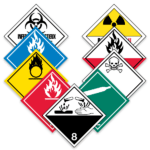
PHMSA Publishes HM-215Q Final Rule on Harmonization
International harmonization of regulatory requirements is always a moving target. Most regulations regarding transport of dangerous goods, including the “Hazardous Materials Regulations” (HMR) of Title 49 of the Code of Federal Regulations (49 CFR), are based on an international standard published by the United Nations (UN). This standard, the United Nations Recommendations on the Transport of Dangerous Goods – Model Regulations (UN Recommendations) is updated once every two years, so national regulators are constantly busy trying to keep their regulations from getting out of date.
The most recent update to the American hazardous materials regulations can be found in a Final Rule from the Pipelines and Hazardous Materials Safety Administration (PHMSA), part of the U.S. Department of Transportation. This rule, titled “Hazardous Materials: Harmonization With International Standards” and assigned the docket number HM-215Q, intends to update to most (but not all) of the 22nd revised edition of the UN Recommendations, as well as correcting some miscellaneous errors and omissions that have been noticed along the way.
What Changes Will We See in HM-215Q?
The changes in this Final Rule include:
- Updated standards that are “incorporated by reference,” including the 22nd revision of the UN Recommendations, the 2023-2024 edition of the International Civil Aviation Organization Technical Instructions for the Safe Transport of Dangerous Goods by Air (ICAO Technical Instructions) and Amendment 41-22 to the International Maritime Dangerous Goods Code (IMDG Code).
- Steps for harmonizing the requirements for gas cylinders with Canadian and international standards.
- Updates to the Hazardous Materials Table to include a new shipping description for Cobalt dihydroxide powder and to correct various small mistakes or discrepancies in certain entries.
- Revising some of the special provisions found in section 172.102.
- Clarifying some of the de minimis requirements in section 173.4b that have to do with biological samples containing formaldehyde.
- The entries for polymerizing substances that were entered in HM-215N as temporary options have been made permanent.
- Introducing a new test method for assigning packing groups to Class 8, Corrosives, that would not involve live animal testing.
- Updating section 173.167, on using ID8000, Consumer commodity, to meet the current ICAO standards and to clarify that these provisions are not related to the old ORM-D “consumer commodity” standard that was U.S. – only.
Regulations on lithium batteries are a constantly-evolving field, and HM-215Q has quite a lot on updates for them. PHMSA has made the following revisions to section 173.185:
- Removing the requirement for a signature on the lithium battery test summary.
- Amending paragraph (a)(3) to except button cell batteries from the test summary requirements if they are shipped installed in equipment.
- Requiring the marking of the Watt-hour (Wh) rating on the casings of large (high-powered) lithium batteries (originally this was only required for low-powered batteries).
- Clarifying packing requirements for lithium batteries packed with equipment.
- Adding a new paragraph (b)(4)(iv) clarifying that for transportation by aircraft, when multiple pieces of equipment are packed in the same outer packaging, each piece of equipment must be packed to prevent contact with other equipment.
- Removing exceptions for small batteries transported by air that do not correspond to the exceptions found in the ICAO Technical Instructions. This has resulted in a reorganization of section 173.185(c)(4).
- Introducing a new stacking test requirement for batteries offered for transport in accordance with section 173.185(c)(5).
- Removing the requirement for a telephone number on the Lithium Battery Mark. The telephone number will be considered optional until December 31, 2026, after which it will not be permitted. This accords with UN and ICAO policies.
- Making editorial changes to convert references from “battery assemblies” to “cells and batteries” in accordance with UN usage.
What Do You Need to Do about This?
The effective date of the rule is May 10, 2024. However, optional compliance has been backdated to January 1, 2023, which means you may comply before May 10 if you wish. Mandatory compliance will be April 10, 2025.
Questions?
ICC the Compliance Center will, of course, be watching as PHMSA progresses through the regulatory development process. If you have any questions, contact ICC Compliance Center, we can advise you on current and upcoming regulations. Our team of experts is just a call away for our customers at 855.734.5469 or send us an email, we’re happy to help.
Stay up to date and sign up for our newsletter!
We have all the products, services and training you need to ensure your staff is properly trained and informed.
 49 CFR Publications 49 CFR Publications |
 UN Approved UN ApprovedPackaging and Boxes |
 Hazard Class Labels Hazard Class Labels |
Sources:
Federal Register, April 10, 2024, “Hazardous Materials: Harmonization with International Standards – Final Rule”
United Nations, 2021, Recommendations on the Transport of Dangerous Goods – Model Edition, 22nd Revision





